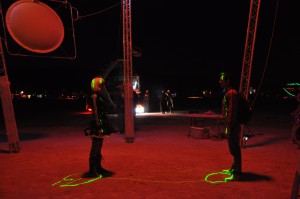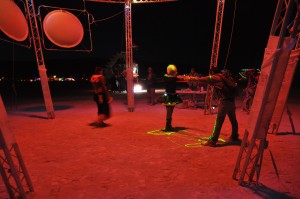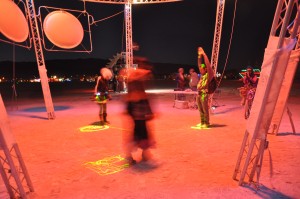@Charity_Robison
Hello, my name is Charity and I am a post-bach student in the DTC program. I come from a fine arts background so my challenge is to transfer what I can of my studio skills and knowledge into a digital format that I can use to further my language of expression.
Math offends me and the digital realm is challenging with its limited tactile process and lack of physical or organic matter to touch, feel, and manipulate with my hands. It also looks a lot like math..
There are a great many new media objects to chose from so I decided to simply look over the slides and see what came to mind. This random exploration worked out well and resulted in some unexpected recollections. When I looked over interactive installations, I was immediately taken to an experience I had at Burning Man in 2009 with an installation titled Steve the Robot H.E.Ai.D.
It is described as “a Human Energized Artificial Intelligence Device that encouraged collaborative sound and music making inside a giant 35 foot structure made to resemble a giant robot head. Motion is detected using a camera mounted at the peak of the structure, which is then used to generate sound and project the laser image.”
I had come to it out on the playa late one night and found myself completely fascinated by the physical and visible connection I had with the piece. I danced with someone and watched it trace my every move along with theirs via laser lights onto the playa dust beneath me. I was actually watching the electricity and energy between myself and another.
In relation to the characteristics of new media by Lev Manovich, I believe this met all five. By creating an interactive connection between a computer and the human body, numerical representation (p.27) was made via intelligence that communicated between various systems to create the whole. There is an algorithm recording and transcribing human movement into a digital format.
The numeral representation here incorporated modularity (p.30) by combining several methods of data gathering to create the cohesive result of man and machine. This is also, in part, an automative (p.32) process. Computers have been explicitly designed and programed to record the human or analog movement and transcribe them into a digital format that can then be further translated into a visual shape and form. Variability (p.36) is then nearly infinite as it is defined by each individual that interacts with it, recording not only their physical stature and form, but also their movement. Transcoding (p.45) follows with the materialization of this digital interpretation of an analog subject. The human body and its movements are displayed in a digital format via laser lights.
Here is a short video clip of the installation:




